Home Decor
Upcycling Thrifted Treasures With Paint
Awaken the artist within by transforming discarded thrift store finds into unique decor pieces that reflect your personal style with a stroke of creativity.
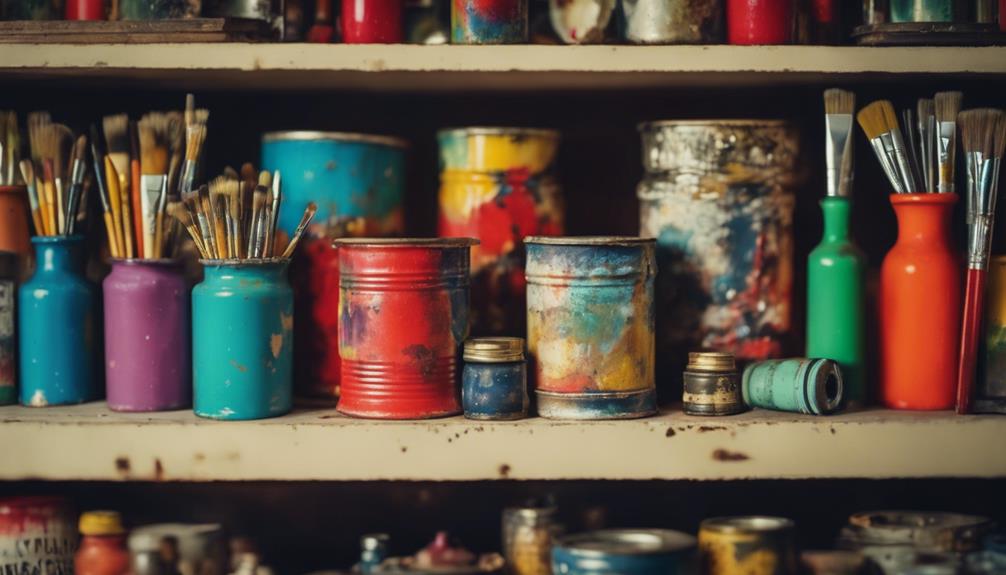
When we stumble upon thrifted treasures, the real magic happens when we upcycle them with paint. We scour thrift stores for quality materials like solid wood, ceramic, or glass, checking for structural integrity and uniqueness. After thorough cleaning and light sanding, we prime and paint our finds, choosing the right type for the project. We master basic brushstroke methods, experiment with decoupage, and distress for a vintage look. Finally, we seal our masterpieces with topcoats and add embellishments for a polished finish. With a little creativity, our discarded treasures transform into one-of-a-kind decor pieces that reflect our personal style, and the best part? There's even more to explore.
Key Takeaways
• Hunt for hidden gems with quality materials like solid wood, ceramic, or glass at thrift stores for upcycling projects.
• Thoroughly clean and lightly sand surfaces for better paint adhesion and a professional finish.
• Choose the right paint type for the project, considering options like chalk, acrylic, milk, or spray paint for durability.
• Master basic brushstroke methods and experiment with different effects, such as layering and blending, for a unique look.
• Seal upcycled pieces with a topcoat for protection and durability, following manufacturer's instructions for a polished appearance.
Thrift Store Hunting 101
As we venture into the world of thrift store hunting, we're on the lookout for hidden gems that can be transformed into one-of-a-kind masterpieces with a fresh coat of paint. When we're thrift store hunting, we're not just browsing for anything that catches our eye; we're on a mission to find quality materials that will take our upcycling project to the next level. We're looking for solid wood, ceramic, or glass items that have the potential to be reborn with a new look.
We're checking for structural integrity, making sure the item is functional and in good condition, so we can envision the before and after. The idea of painting and transforming these thrifted treasures into personalized decor pieces is what drives us. We're not limited by the original design; we're going to paint and reimagine it to fit our unique style.
As we hunt, we're considering the size and scale of the item, ensuring it fits our space and vision. By keeping an open mind and thinking outside the box, we can stumble upon one-of-a-kind finds that will make our upcycling project truly special.
Preparing Your Treasure for Paint
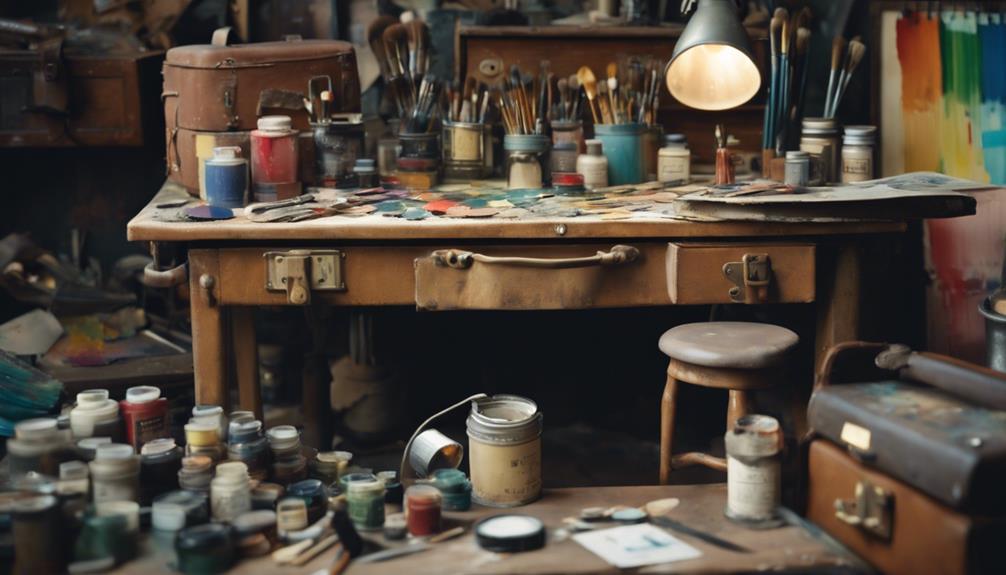
We've curated our thrift store finds, and now it's time to get our treasures ready for their makeover, starting with a thorough cleaning to remove any dirt or grime that might interfere with the paint. Going through this process is absolutely necessary to guarantee a professional finish.
We needed something more than just a quick wipe-down, so we grabbed some soap and water to give our treasures a good scrub.
Here are the essential steps to prepare our treasures for painting:
- Clean thoroughly: Remove dirt and grime with soap and water to prevent interference with paint adhesion.
- Sand lightly: Create a rough texture for better paint adhesion on surfaces like wood, metal, or plastic.
- Prime if needed: Apply a primer to guarantee the paint sticks well to different materials.
- Dry completely: Allow each coat of paint to dry completely before applying the next layer for a lasting result.
Choosing the Right Paint Type
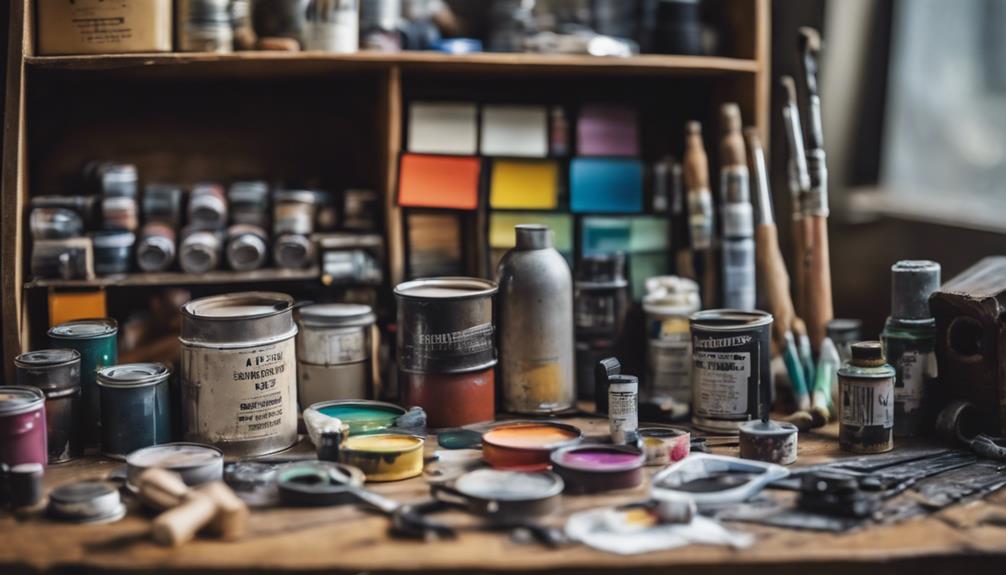
When delving into the world of upcycling thrifted treasures with paint, we need to explore the various paint types that can help us achieve our desired look.
From matte finishes to glossy coats, the right paint type can make all the difference in transforming our finds into unique masterpieces.
Paint Finish Options
When it comes to upcycling thrifted treasures, selecting the right paint type can make all the difference in achieving the desired look and durability. We want to make sure we choose a paint that not only enhances the appearance of our finds but also withstands the test of time.
One thing we need to contemplate is the finish we want to achieve. Do we want a matte, vintage look or a glossy, modern finish?
Here are some paint finish options to contemplate:
- Chalk paint for a matte, vintage look on thrifted treasures.
- Acrylic paint for a durable, glossy finish on upcycled items.
- Milk paint for a classic, time-worn appearance on repurposed decor pieces.
- Spray paint for a quick and even application on a variety of surfaces.
Best Paint Brands
Generally, we stick to popular paint brands like Annie Sloan Chalk Paint, Fusion Mineral Paint, and Dixie Belle Paint that cater specifically to furniture and decor projects, ensuring durability and excellent coverage.
When it comes to upcycling thrifted treasures, we want paints that can deliver on quality and performance. I'm going to emphasize that selecting the right paint type is vital, as it can make or break the entire project.
We've found that these popular brands offer a range of finishes, from matte to modern, and are designed to adhere well to different surfaces. Whether you're going for a vintage look with chalk paint or a sleek finish with mineral paint, these brands have got you covered.
Painting Techniques for Beginners
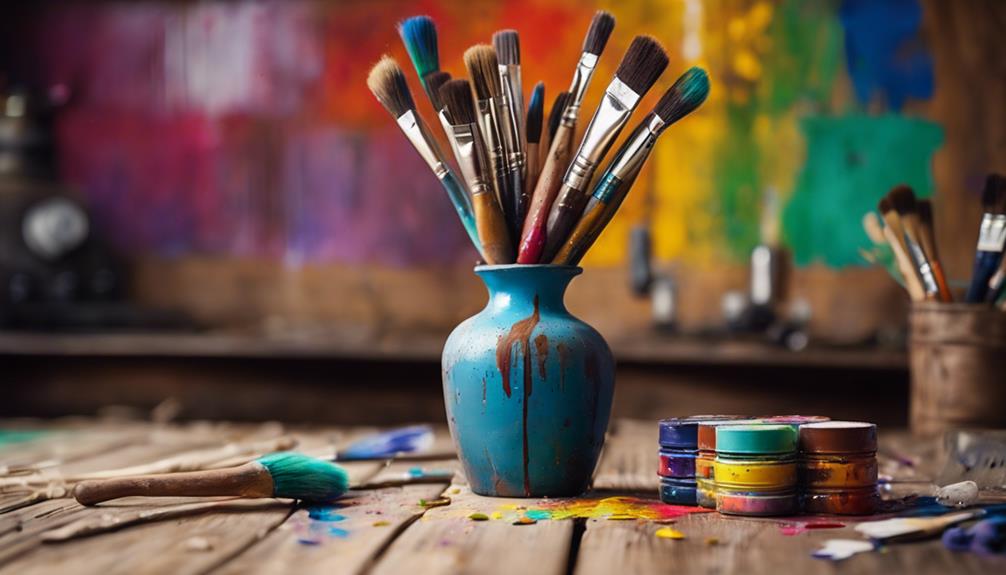
As we explore the world of upcycling, we're excited to share our favorite painting techniques for beginners, which will help us reveal the full potential of our thrifted treasures.
From mastering basic brushstroke methods, such as smooth strokes and textured sweeps, to grasping essential color theory tips, like the 60-30-10 rule, we'll discover how to bring our creations to life.
Basic Brushstroke Methods
We explore the world of basic brushstroke methods, where mastering a few fundamental techniques can elevate our upcycled creations from ordinary to extraordinary. By understanding the different brushstrokes, we can discover a world of creative possibilities. There are three primary brushstroke methods to grasp: flat, round, and liner. Each serves a specific purpose, and knowing when to use them can make all the difference.
Here are the basics of each brushstroke method:
- Flat Brushstroke: Ideal for filling in large areas with paint, perfect for creating bold backgrounds or solid colors.
- Round Brushstroke: Great for creating curved lines and shapes, adding a touch of elegance to our upcycled treasures.
- Liner Brushstroke: Used for fine details and thin lines, adding intricate designs to our projects.
- Practice and Experiment: Don't be afraid to try out different brushstrokes on a spare piece of material, blending colors, layering strokes, and varying brush sizes to achieve unique effects.
Essential Color Theory Tips
With our brushstroke techniques in hand, we're ready to harness the full potential of our upcycled creations by mastering the art of color selection.
As beginners, understanding color theory basics is important in choosing complementary or contrasting colors for our projects. Let's start with the fundamentals: primary colors – red, blue, and yellow – can be mixed to create secondary colors – orange, green, and purple – expanding our color palette.
Warm colors like reds, oranges, and yellows evoke energy and vibrancy, while cool colors like blues, greens, and purples create a calming effect. When selecting colors, we can opt for analogous colors, which are next to each other on the color wheel, for a harmonious look, or complementary colors, opposite on the wheel, for contrast.
Additionally, experimenting with shades, tints, and tones of colors can add depth and dimension to our painted thrifted treasures.
Simple Stenciling Techniques
We'll start by exploring simple stenciling techniques, a perfect way to add intricate designs and patterns to our upcycled treasures without needing extensive artistic skills. This technique is great for beginners, as it's easy to master and produces impressive results.
Here are the basic steps to get you started:
- Secure the stencil: Use painter's tape or adhesive spray to make sure the stencil is firmly attached to your surface.
- Apply paint evenly: Use a stencil brush or sponge to apply paint, making sure to cover the entire design. Avoid applying too much pressure, which can cause paint to bleed under the stencil edges.
- Lift the stencil: Carefully remove the stencil to reveal your design. Clean the stencil for reuse or different projects.
- Repeat and experiment: Try out different stencil designs, colors, and patterns to create unique and personalized upcycled pieces.
Adding Texture With Decoupage
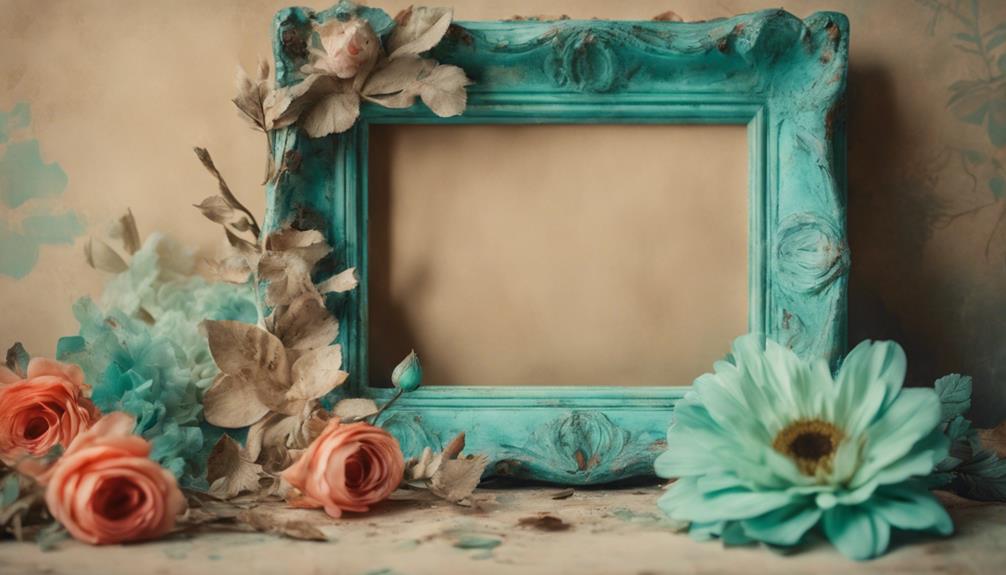
By incorporating decoupage into our upcycling process, we can infuse our thrifted treasures with a tactile quality that draws the eye and invites touch. This technique involves gluing images or decorative paper onto a surface, adding texture and visual interest to our upcycled items.
We can take it a step further by layering decoupage paper or images with a sealant like liquid patina or Big Top, creating a durable and textured finish. Decoupage can be used on various surfaces, from wood to metal to glass, transforming thrifted items into unique decor pieces.
Experimenting with different types of decoupage paper, such as vintage prints or botanical images, allows us to add character and charm to our upcycled treasures. By using decoupage, we can personalize and enhance the look of our thrifted finds, making them stand out in our home decor.
With a little creativity, we can turn ordinary items into extraordinary pieces that reflect our personal style.
Distressing for a Vintage Look
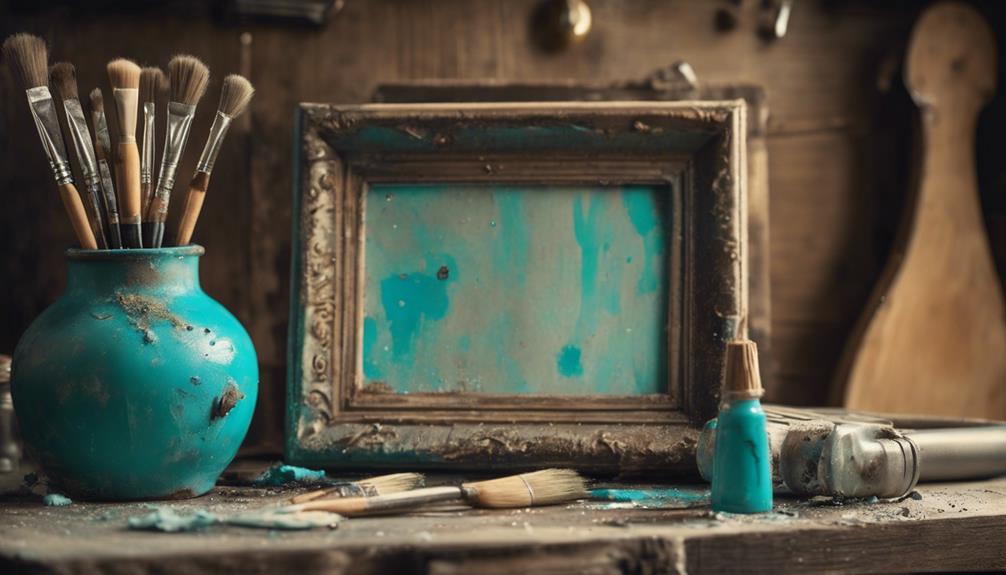
As we move beyond adding texture with decoupage, we're now ready to explore another way to inject character into our upcycled pieces: distressing for a vintage look. Distressing involves intentionally aging or weathering painted surfaces to create a unique, rustic appearance. By using techniques like sanding, scraping, or using tools like sandpaper or steel wool, we can add texture, depth, and character to our upcycled treasures.
Here are some key things to keep in mind when distressing:
- Start with a base coat: A solid base coat is essential for a successful distressing process.
- Choose your tools wisely: From sandpaper to steel wool, the right tools can make all the difference in achieving the desired level of distress.
- Distress in layers: Work in layers to achieve a nuanced, multi-dimensional look.
- Practice makes perfect: Don't be discouraged if your first attempts at distressing don't turn out as expected – it takes practice to master the technique.
Sealing Your Masterpiece
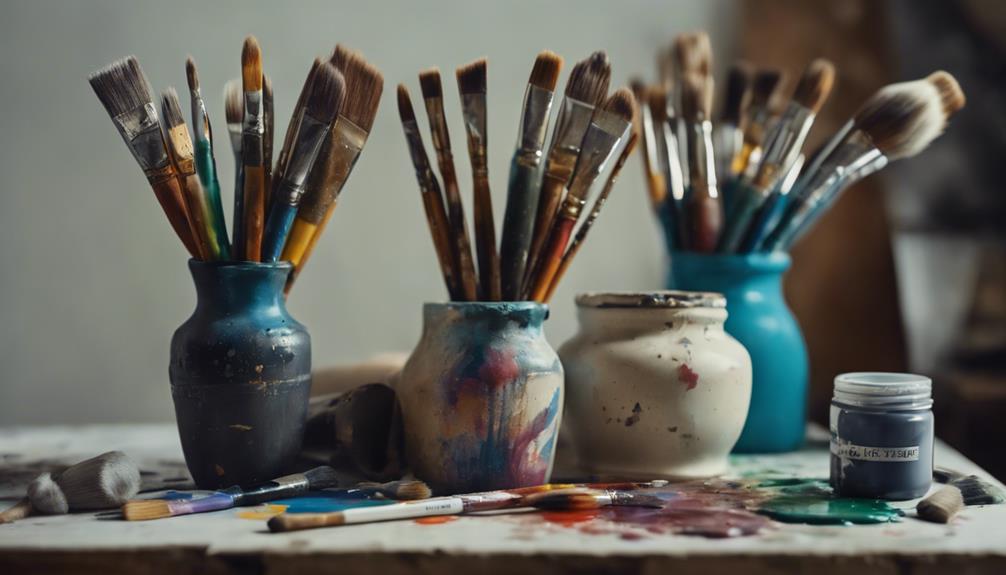
Now that we've achieved the desired level of distress, it's time to seal our masterpiece with a topcoat, guaranteeing our hard work remains vibrant and protected for years to come.
Sealing our upcycled treasures with a topcoat like Big Top helps safeguard the paint and finish from wear and tear, providing a durable and long-lasting finish.
By applying a topcoat after painting and distressing, we can enhance the look of our upcycled items and give them a professional finish.
Following the manufacturer's instructions when applying a topcoat is crucial to properly seal our painted projects. This step not only protects the paint but also adds a polished and finished appearance to our creations.
Adding Embellishments and Accents
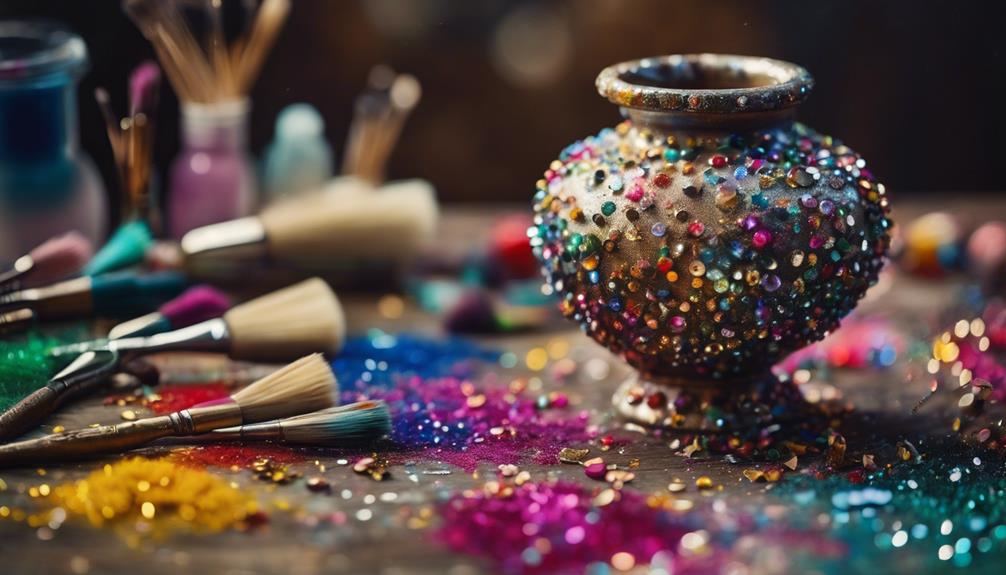
As we continue to breathe new life into our thrifted treasures, we're excited to explore the world of embellishments and accents.
Here, the right textures and metallic accents can elevate our creations from ordinary to extraordinary. By incorporating different textures, such as lace, fabric, or beads, we can add depth and visual interest to our upcycled pieces.
Whether we're aiming for a vintage, distressed look or a sleek, modern aesthetic, the right embellishments and accents can help us achieve a truly one-of-a-kind design.
Embellishing With Textures
We can instantly elevate our upcycled creations by incorporating textured elements, which add depth, visual interest, and a touch of personality to our thrifted treasures. By doing so, we can create unique pieces that reflect our personal style and taste.
To get started, we can try incorporating the following textured elements into our projects:
- Twine or tags: Add a rustic touch to your upcycled decor with twine or tags that evoke a vintage feel.
- Beads, buttons, or charms: Incorporate small embellishments like beads, buttons, or charms to add a touch of whimsy and personality to your project.
- Fabric scraps, lace, or ribbons: Experiment with different textures and patterns by incorporating fabric scraps, lace, or ribbons into your design.
- Stencils, stamps, or embossing techniques: Add intricate textures and designs to your painted thrifted treasures using stencils, stamps, or embossing techniques.
Adding Metallic Accents
We can reveal the full potential of our upcycled thrift store finds by incorporating metallic accents, which instantly add a touch of sophistication and glamour to our creations.
With metallic paints in shades of gold, silver, or copper, we can highlight details or edges on furniture, frames, or decorative items, giving them a luxurious finish. These accents can transform vintage pieces into stylish decor elements, perfect for modernizing our thrifted treasures.
To achieve unique metallic effects, we can experiment with different application techniques, such as dry brushing or stenciling. By adding metallic accents, we can enhance the overall aesthetic of our upcycled projects, making them stand out in any room.
Whether we're going for a sophisticated look or a trendy vibe, metallic accents can help us achieve our desired style. With a little creativity and experimentation, we can reveal the full potential of our thrifted treasures and turn them into stunning pieces that showcase our personal taste and flair.
Upcycling Ideas to Get You Started
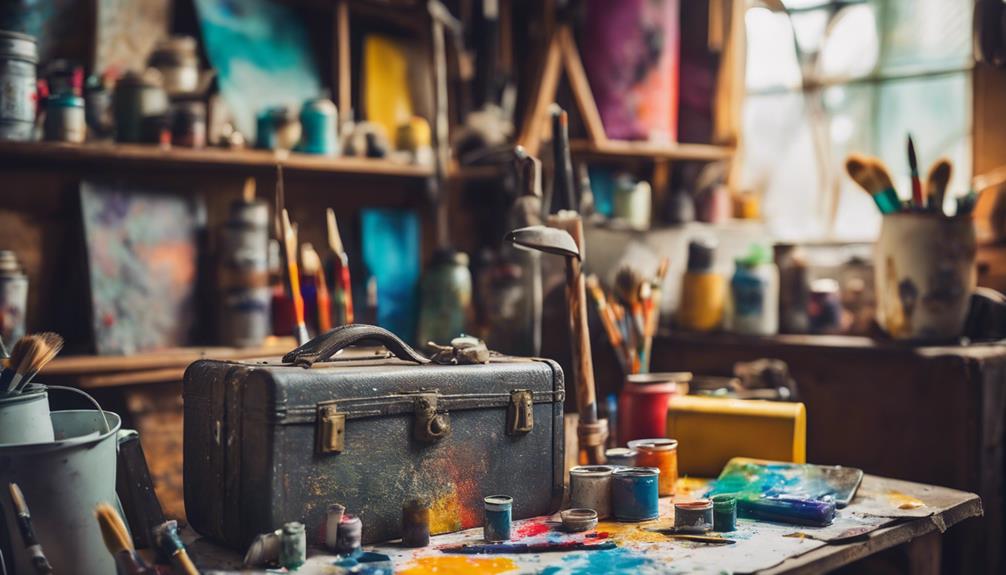
Let's immerse ourselves in some inspiring upcycling ideas to get us started on transforming those thrifted finds into one-of-a-kind decor pieces. We can experiment with different techniques like painting, distressing, and sealing to give our second-hand treasures a fresh new look. Adding details like decoupage, twine, or stencils can enhance our upcycled creations.
Here are some ideas to get us started:
- Vintage Window Makeover:
Paint an old window with a soft, pastel color and add some distressed details to create a beautiful decorative piece.
- Mason Jar Revamp:
Transform old mason jars into beautiful vases by painting them with bold, bright colors and adding some decorative twine.
- Old Door Turned Headboard:
Upcycle an old door into a one-of-a-kind headboard by painting it with a bold, contrasting color and adding some decorative stencils.
- Thrifted Vase Makeover:
Give an old vase a fresh new look by painting it with metallic accents and adding some decoupage details.
Displaying Your Upcycled Masterpiece
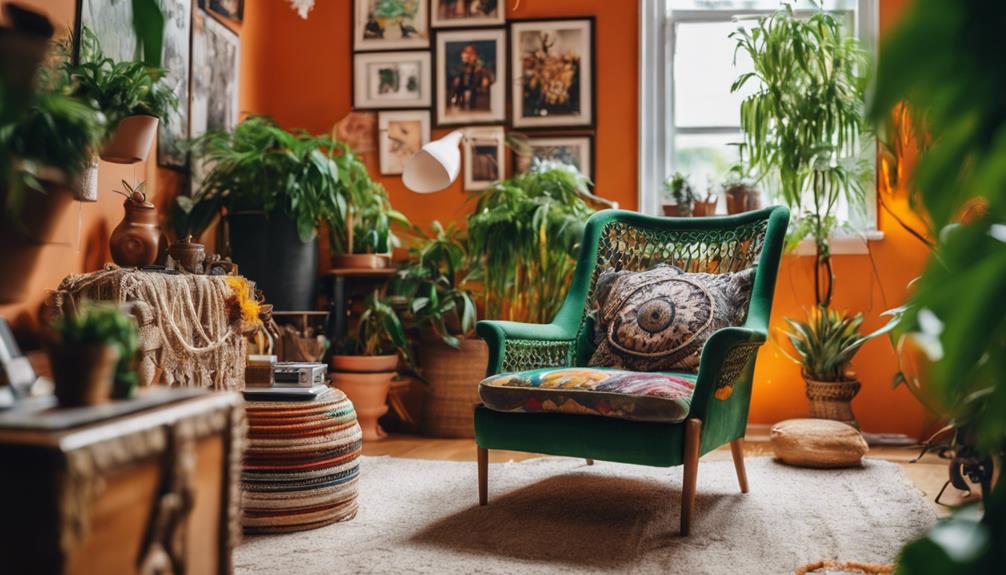
Now that we've transformed our thrifted finds into unique decor pieces, it's time to showcase our creative handiwork in a way that adds visual appeal to our homes. To do this, we need to think strategically about how to display our upcycled masterpieces.
Here are some ideas to get us started:
| Display Idea | Tips and Variations |
Showcase on Shelves
Use floating shelves or traditional ones with decorative brackets
Create a Vignette
Group similar items together for a cohesive look
Add a Personal Touch
Incorporate photos, plants, or other decor items
Rotate Seasonally
Update our displays periodically to keep things fresh
Highlight a Theme
Emphasize a particular style or theme in our upcycled pieces
Frequently Asked Questions
What Paint to Use for Upcycling Furniture?
When deciding what paint to use, we consider the look we want to achieve – do we want a vintage vibe, a smooth finish, or durability?
How to Upcycle Furniture for Beginners?
We're new to upcycling, so we start by researching basics like preparing surfaces, choosing the right paint, and mastering simple techniques, then gradually experiment with more complex designs and embellishments.
Conclusion
As we conclude our upcycling journey, we're left with a sense of accomplishment and a hint of curiosity – what's next?
With our newly acquired skills, we're poised to transform thrift store finds into one-of-a-kind masterpieces.
But, as we gaze upon our latest creation, we can't help but wonder: what hidden treasures await us in the thrift stores of tomorrow, waiting to be reborn with a stroke of our brush?
Home Decor
Things You Didn't Know About Using Natural Textures in Country Design
Uncover the secrets of natural textures in country design that can elevate your home's charm and warmth in unexpected ways.
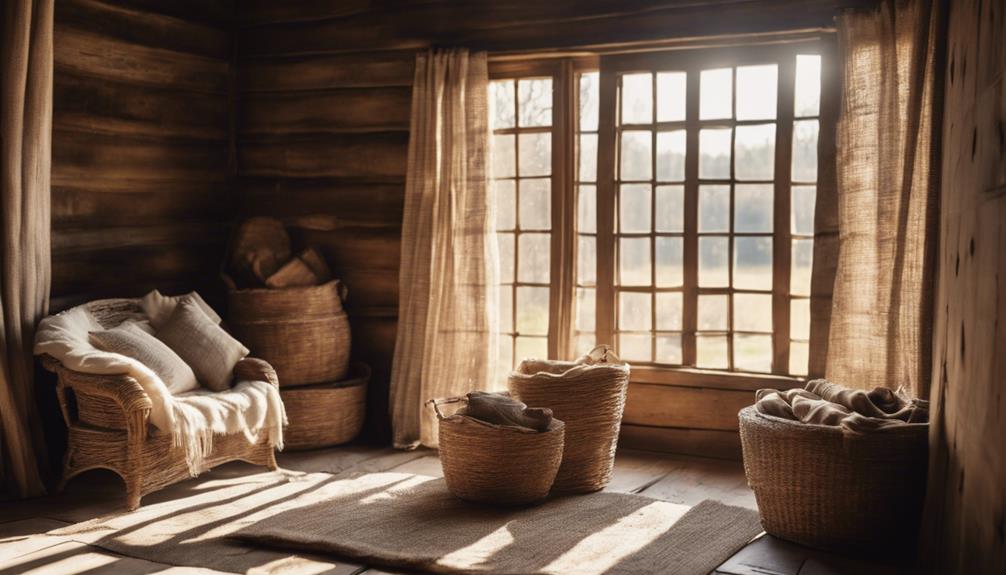
Using natural textures in country design can transform your home into a cozy retreat. You might not know that reclaimed wood and stone not only provide warmth but also tell a story of sustainability and individuality. Incorporating natural fibers like linen and wool enhances comfort while rough-hewn accents add rustic charm. Lighting plays a vital role too; rustic lanterns and candle sconces can create an inviting atmosphere. Additionally, decorative items like handwoven baskets and ceramic pottery add character. Each choice contributes to a harmonious design that feels authentic. If you're curious, you'll discover even more delightful ideas and tips ahead.
Key Elements
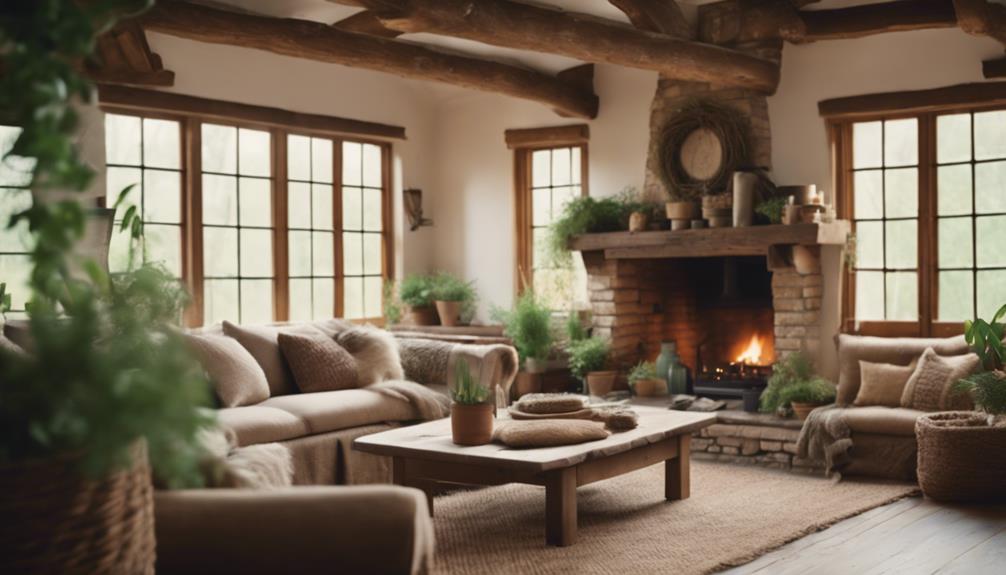
When you think about key elements in country design, focus on the color scheme, materials, and textures.
These aspects work together to create a cohesive look that feels both inviting and authentic.
Color Scheme
Incorporating earthy tones like warm browns and soft greens into your color scheme enhances the rustic appeal of country design. These colors not only reflect the beauty of natural materials but also create a warm, inviting atmosphere.
Layering different shades of the same color can add depth, allowing textures like wood and stone to shine through. For instance, using a range of muted blues alongside your earthy tones can make your space feel cohesive and inviting.
Textured materials such as linen and burlap introduce subtle color variations that enhance the overall warmth without overwhelming the room. You might also consider incorporating natural elements like floral patterns or botanical prints to add pops of color that harmonize with your neutral base. These accents can mirror the beauty of the surrounding landscape.
Don't forget to embrace seasonal color schemes as well! Inspired by nature's changing hues, you can refresh your design by incorporating richer tones in fall and lighter pastels in spring. This approach keeps your country design lively and connected to the natural world, making your space feel both dynamic and rooted in tradition.
Materials
Natural textures play an essential role in country design, with materials like reclaimed wood and stone bringing warmth and character to your space.
Reclaimed wood not only adds a rustic charm but also promotes sustainability by repurposing existing resources, making your home feel both inviting and environmentally friendly. Stone, often used in fireplaces and accent walls, contributes durability and a cozy aesthetic that's perfect for country living.
When it comes to textiles, opting for natural fibers like linen and cotton for upholstery and drapery enhances the breathable quality of your interiors, creating a relaxed atmosphere. You can also incorporate hand-forged iron or wrought iron fixtures, which add authenticity and unique, artisanal touches to your design.
For flooring, consider natural fiber area rugs made from jute or sisal. These materials provide texture and help ground the space with their earthy tones, enhancing the overall feel of natural textures in your home.
Textures
Textures like rough-hewn wood and weathered stone instantly bring depth and warmth to your country design, making your space feel inviting and full of character. By incorporating natural textures, you create an atmosphere that reflects the charm of rural living.
Think about using textiles like linen, cotton, and wool for upholstery and curtains; they enhance the tactile experience and offer a comforting connection to nature.
Unique textures, such as the grain patterns in reclaimed wood furniture or the softness of hand-spun wool rugs, introduce individuality to your interiors. Layering different textures—like smooth ceramics with coarse jute or burlap—creates visual interest while adding coziness, essential to country design aesthetics.
Consider natural elements like stone fireplaces or driftwood accents. These not only serve as focal points but also tell a story of craftsmanship and the surrounding environment, enriching your overall design narrative.
Embracing these textures allows you to craft a space that feels both authentic and personal, drawing people in and making them feel at home. So, don't shy away from mixing textures—your design will thrive on their beauty.
Essential Fixtures and Furniture
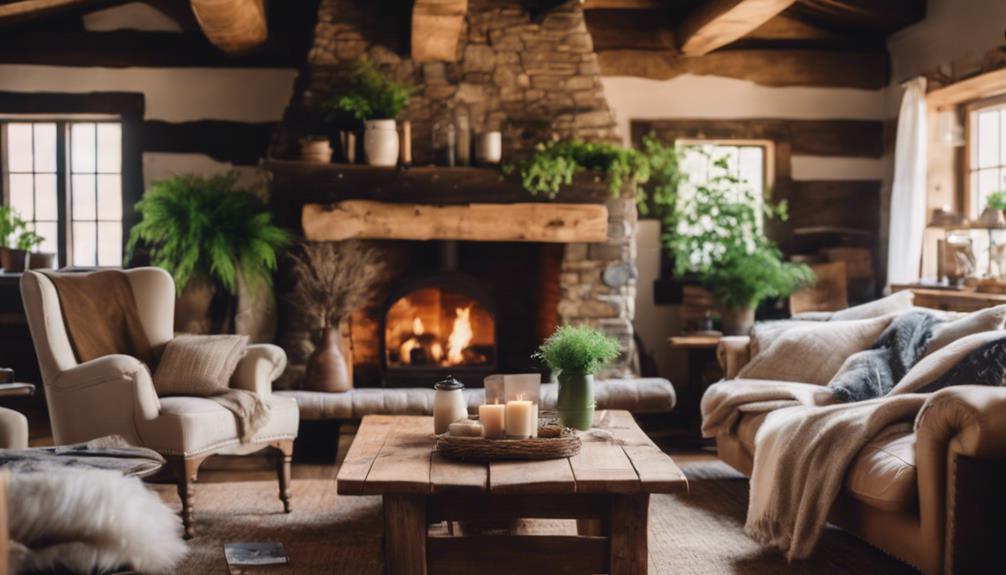
When you think about essential fixtures and furniture in country design, consider how a reclaimed wood dining table can serve as the heart of your home.
Pair it with an antique wrought iron chandelier and vintage farmhouse wall sconces to create a warm, inviting atmosphere.
These elements not only enhance the aesthetic but also tell a story, making your space feel truly unique.
Reclaimed Wood Dining Table
A reclaimed wood dining table not only serves as a stunning centerpiece for your dining area but also brings a unique story and warmth to your home. Crafted from salvaged timber, these tables reduce waste and add character, making each piece truly one-of-a-kind.
With their beautiful grain patterns and natural imperfections, reclaimed wood dining tables enhance the rustic charm of your space, creating an inviting atmosphere for family meals and gatherings.
You'll appreciate the durability of reclaimed wood; it's typically more stable than new lumber because it has had time to cure and settle. This means it's less likely to warp or split over time, ensuring your table stands the test of everyday use.
Antique Wrought Iron Chandelier
Antique wrought iron chandeliers instantly become striking focal points in any country design, showcasing intricate craftsmanship that adds historical authenticity to your space.
These handcrafted fixtures not only highlight the artisanal quality of natural materials but also align with the trend toward unique home styles. When you incorporate a wrought iron chandelier, you introduce a raw, organic element that beautifully contrasts with the softer textures of wood and textiles found in country interiors.
The design of these chandeliers often features decorative elements like scrollwork or floral motifs, enhancing the overall charm and character of your home style. By choosing an antique piece, you're not just elevating the visual interest of a room; you're also making a sustainable choice. Using repurposed materials with a rich history reflects a commitment to eco-friendly design.
Whether you hang it over a dining table or in a cozy living room, an antique wrought iron chandelier adds warmth and sophistication to your space. Embrace this timeless fixture to create a welcoming atmosphere that resonates with the beauty of country design and makes your home truly unique.
Vintage Farmhouse Wall Sconces
Vintage farmhouse wall sconces provide essential lighting that enhances the rustic charm of your country design while showcasing intricate craftsmanship. Often made from materials like wrought iron or aged brass, these sconces add a touch of authenticity that complements your home's aesthetic. Their detailed designs and unique patinas tell stories of history, making them perfect for vintage-inspired spaces.
You'll find that many vintage farmhouse wall sconces accommodate candle-style bulbs, creating a warm, inviting glow. This soft illumination beautifully highlights natural textures like wood and stone, enriching your décor. By strategically placing sconces, you can draw attention to architectural features, artwork, or textured walls, adding depth and interest to your living space.
Incorporating vintage wall sconces not only preserves the authenticity of farmhouse design but also aligns with the growing trend of sustainability. By repurposing these timeless fixtures, you contribute to an eco-friendly approach while enhancing your home's charm.
Lighting Ideas
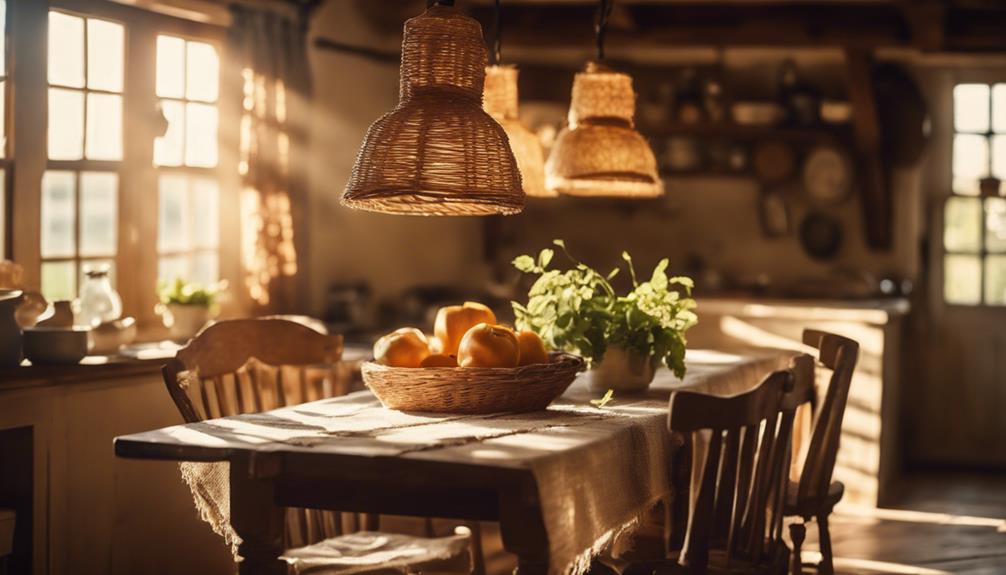
When you think about lighting in a country design, consider rustic lantern pendant lights and soft glow candle wall sconces to set the mood.
Antique farmhouse table lamps and vintage glass jar lanterns can add unique touches that enhance the overall aesthetic.
These choices not only illuminate your space but also bring in those natural textures that define country style.
Rustic Lantern Pendant Lights
Rustic lantern pendant lights add a charming touch to your country design, blending natural materials with warm, ambient lighting for a cozy atmosphere. These fixtures often feature wrought iron or distressed wood, perfectly complementing the natural textures that define country interiors. By incorporating rustic lantern pendant lights, you create a focal point in spaces like dining rooms or kitchens, enhancing both character and functionality.
Inspired by traditional outdoor lighting, these lights offer a timeless appeal that fits seamlessly into modern and classic country settings. You can choose from various sizes and styles, allowing you to use rustic lantern pendant lights in clusters or as standalone pieces, depending on your design vision.
Whether you're aiming for a rustic farmhouse vibe or a more contemporary take, these lanterns can elevate your space while providing the necessary illumination. When you select rustic lantern pendant lights, you're not just lighting a room; you're enhancing the overall aesthetic of your home.
Embrace their beauty and practicality to make your country design truly shine.
Soft Glow Candle Wall Sconces
Soft glow candle wall sconces bring a warm ambiance to your country design, effortlessly enhancing the cozy atmosphere that defines this style. These sconces serve as an excellent way to introduce soft, ambient lighting, making your space feel inviting and serene. Often crafted from natural materials like wrought iron, wood, or ceramic, soft glow candle wall sconces align beautifully with the rustic charm of country decor.
The flickering light from the candles not only creates visual interest but also adds a dynamic element to your wall decor. When positioned strategically, these sconces can accentuate architectural features, such as exposed wooden beams or stone walls, highlighting the beauty of the natural materials around you.
Incorporating soft glow candle wall sconces into your design isn't just about functionality; it's about creating a tranquil environment. They can transform a simple wall into a focal point while providing the perfect glow for relaxation.
Antique Farmhouse Table Lamps
Antique farmhouse table lamps bring a unique blend of charm and functionality to your country design, illuminating your space with warmth and character.
These lamps often feature materials like distressed wood, wrought iron, and ceramic, enhancing the rustic appeal that defines country homes. Their unique craftsmanship showcases intricate designs, such as hand-painted shades or detailed bases, which add depth and history to your decor.
When you incorporate antique farmhouse table lamps into your design, you not only highlight natural textures but also promote sustainability by embracing vintage pieces.
The warm light emitted by these lamps creates an inviting atmosphere, perfect for those cozy evenings spent at home.
As you choose your lamps, pay attention to the scale and style to guarantee they harmonize with other natural elements and furnishings in your space, contributing to a cohesive design.
Vintage Glass Jar Lanterns
Vintage glass jar lanterns bring a unique charm to your country design, effortlessly blending style and sustainability. These lanterns often feature distinctive textures and patterns, enhancing the aesthetic appeal of your space. By repurposing old glass jars, you not only create eye-catching decor but also promote an eco-friendly approach to home lighting.
When you use vintage glass jar lanterns with battery-operated fairy lights or candles, they offer a warm, inviting glow that perfectly complements the cozy atmosphere typical of country design. Mixing different shapes and sizes of jars can create visual interest and depth, allowing for creative arrangements that liven up any room.
Consider incorporating vintage glass jar lanterns into your outdoor settings, such as patios or gardens. Their enchanting illumination adds a nostalgic feel to evening gatherings, making your outdoor space feel even more inviting.
Whether you're hosting friends or enjoying a quiet evening alone, these lanterns enhance both the ambiance and charm of your surroundings. Embrace the rustic elegance of vintage glass jar lanterns and elevate your country design with a touch of natural texture and warmth.
Decorative Elements
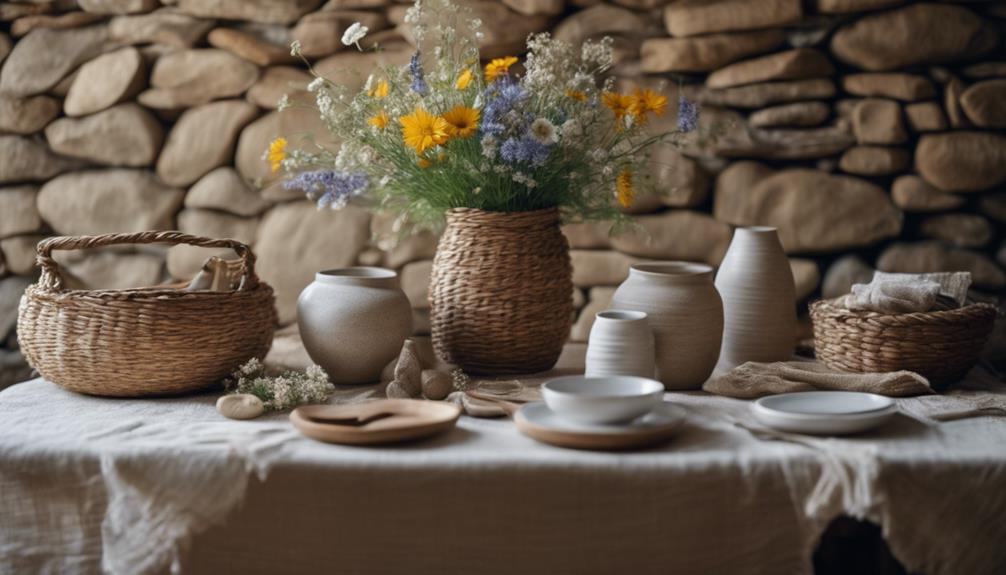
When you think about decorative elements in country design, handwoven wicker baskets and ceramic pottery with floral designs instantly come to mind.
These pieces not only add charm but also connect your space to nature.
Distressed wooden picture frames can beautifully showcase your favorite memories, enhancing the cozy, inviting atmosphere you're aiming for.
Handwoven Wicker Baskets
Handwoven wicker baskets effortlessly blend functionality and charm, making them essential decorative elements that enhance the rustic appeal of country design. You'll find that these baskets come in various sizes and styles, allowing you to use them as planters, wall decor, or organizers on shelves and tables. Their versatility is unmatched, adapting seamlessly to any space.
Using natural materials like willow, rattan, or seagrass, handwoven wicker baskets promote sustainability, aligning perfectly with the eco-friendly principles of country design. When you incorporate these baskets into your decor, you add texture and warmth, creating an inviting atmosphere that beautifully complements natural elements like wood and stone.
Moreover, the unique patterns and weaves of wicker baskets often tell a story of craftsmanship and tradition, infusing your home with character and a sense of history. Whether you're displaying a basket filled with fresh produce in the kitchen or hanging a decorative piece on the wall, handwoven wicker baskets elevate the aesthetic of your country-themed interiors.
Embrace their charm, and watch as your space transforms into a cozy, inviting haven.
Ceramic Pottery With Floral Designs
Ceramic pottery adorned with floral designs adds a vibrant touch to your country decor, effortlessly enhancing the natural beauty of your space. These pieces often feature intricate hand-painted patterns that evoke nature's charm, making them a perfect fit for your country home. You can choose from various styles, whether you prefer rustic, earthy tones or bright, lively colors, allowing for seamless integration into different country decor themes.
Many artisans use local materials in their ceramic pottery, deepening the authenticity and connection to the landscape that defines country design. Floral motifs on these pieces serve not just as decorative elements but also reflect seasonal themes, bringing freshness and vibrancy to both indoor and outdoor spaces.
Incorporating ceramic pottery with floral designs helps create a warm, inviting atmosphere in your country home, reinforcing the charm and coziness that this style embodies. Whether you display them on shelves, tables, or garden areas, these decorative elements will elevate your decor while celebrating the beauty of nature.
Distressed Wooden Picture Frames
Distressed wooden picture frames bring a rustic charm to your country decor, showcasing your cherished memories while enhancing the warm, inviting atmosphere of your home. Crafted often from reclaimed wood, these frames not only display your favorite photos but also contribute to an eco-friendly aesthetic. The unique imperfections and textures of distressed wooden picture frames create a cozy feel, making them an ideal choice for family portraits and travel snapshots.
You can customize these frames by painting or staining them in various colors to perfectly match your space's color palette. This versatility allows for a seamless integration with other natural materials, like stone and linen, commonly found in country design. By incorporating distressed wooden picture frames, you achieve a layered aesthetic that adds depth to your decor.
Moreover, the trend of using these frames aligns with the growing demand for handcrafted items, as each frame tells its own story and reflects skilled craftsmanship.
Flooring
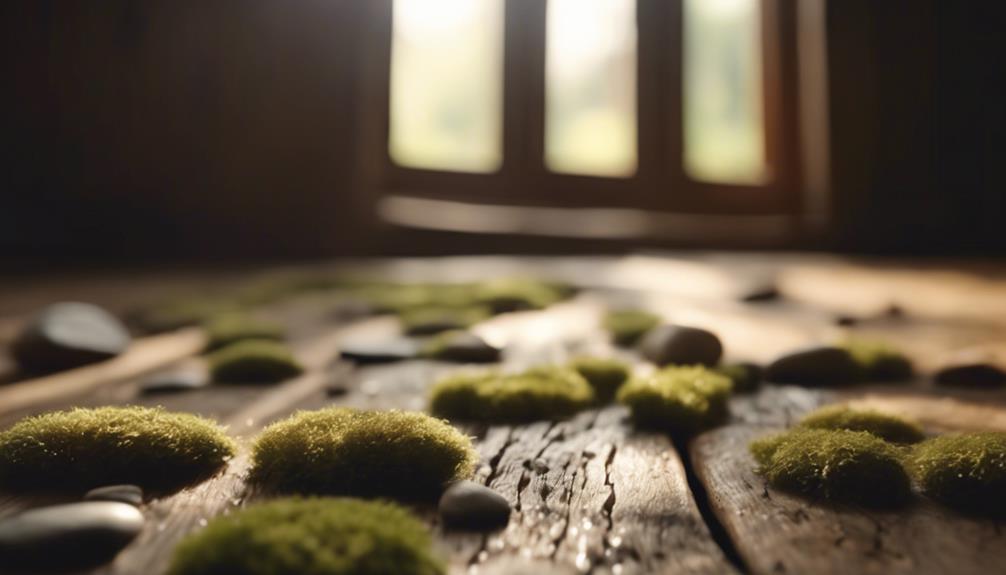
When choosing flooring for your country design, consider the charm of reclaimed barn wood planks, which bring history and warmth to your space.
Cottage-style patterned tiles can add a playful touch while still maintaining that rustic vibe.
Natural stone flagstone tiles not only enhance the aesthetic but also provide durability and functionality for any country home.
Reclaimed Barn Wood Planks
Reclaimed barn wood planks offer a unique blend of history and durability, making them a perfect choice for your country-style flooring. Sourced from deconstructed barns, each plank carries its own story, adding character and warmth to your space. The distinctive markings and patinas found in reclaimed barn wood enhance the authenticity of any country-style interior.
Not only do these planks look great, but they're also an eco-friendly option. By choosing reclaimed barn wood, you're reducing the demand for newly harvested timber and minimizing landfill waste. Plus, this flooring is typically more durable than new wood. Years of exposure to the elements have seasoned it, ensuring it stands the test of time.
Another benefit is that reclaimed barn wood flooring can improve your indoor air quality. Unlike many manufactured wood products, it's often free from harmful chemicals, promoting a healthier living environment for you and your family.
Cottage-Style Patterned Tiles
Cottage-style patterned tiles bring a touch of nature indoors, featuring intricate designs that enhance the warmth and charm of country interiors. These tiles often showcase floral motifs and traditional geometric patterns, adding visual interest to your spaces. Made from natural materials like ceramic or stone, cottage-style patterned tiles offer durability while perfectly complementing the rustic aesthetic of cottage design.
When you incorporate these tiles into your flooring, you create a cozy atmosphere that invites personal expression. With a variety of color palettes and design styles available, you can easily find options that suit your taste. Many of these tiles mimic the vintage look of encaustic cement tiles, giving you a classic feel without sacrificing modern functionality.
Using cottage-style patterned tiles in your kitchen or bathroom not only ties in other natural textures, such as wood and stone, but also contributes to a cohesive country design aesthetic. This blend of materials enhances the inviting nature of your home, making it a warm retreat.
Natural Stone Flagstone Tiles
Natural stone flagstone tiles offer a rugged yet refined flooring option that enhances the charm of country design while providing durability and versatility for both indoor and outdoor spaces. You'll love how these tiles withstand heavy foot traffic, making them a smart choice whether you're laying them in a cozy kitchen or on a sunny patio.
One of the standout features of natural stone flagstone tiles is their variety of textures and colors. This lets you create unique patterns that perfectly complement your country design theme. Plus, their non-slip surface guarantees safety in areas prone to moisture, giving you peace of mind in kitchens or outdoor environments.
When it comes to installation, the dry-set method is key. It promotes natural drainage, preventing water from pooling on the surface, which can be a common concern in outdoor settings.
Not only do these tiles look stunning, but they also add significant value to your home. Buyers are often drawn to the authenticity and quality of natural stone flagstone tiles, making them a wise investment for anyone looking to enhance their country-style living space.
Conclusion
Incorporating natural textures into your country design can truly transform your space.
By focusing on key elements, choosing essential fixtures, and selecting the right lighting, you can create a warm and inviting atmosphere.
Don't forget about decorative elements and flooring that enhance the rustic charm.
Embrace nature's beauty, and you'll find that your home not only looks stunning but also feels cozy and welcoming.
So go ahead, let those textures inspire your next design project!
Home Decor
Create a Relaxing Sanctuary in Your Home – These Tips Will Transform Your Space!
Find out how simple changes can transform your space into a tranquil sanctuary that enhances your well-being and invites relaxation.
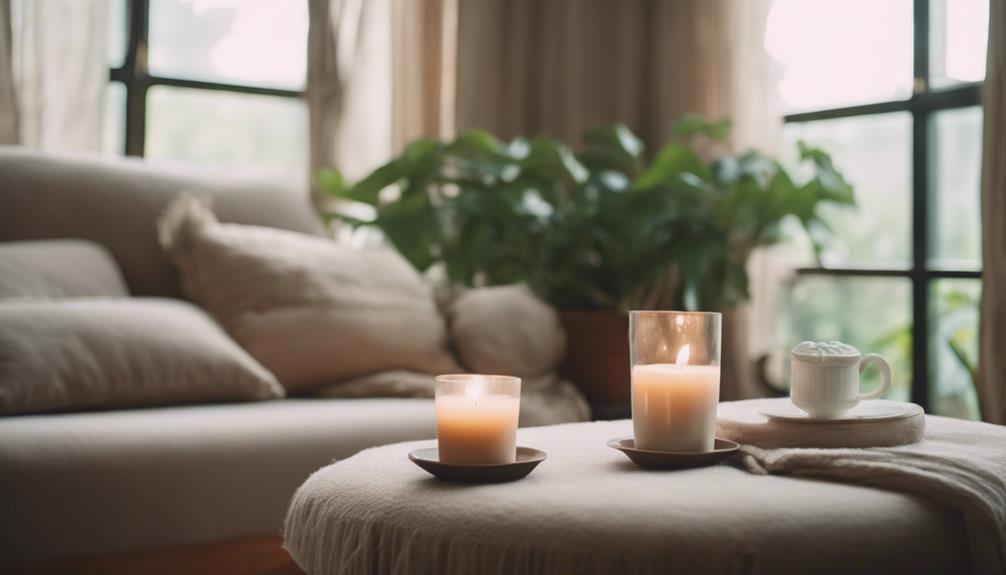
You can easily create a relaxing sanctuary in your home to enhance your well-being. Start by choosing a quiet corner free from distractions. Use calming colors, like soft blues and greens, to paint your walls, and let in natural light. Incorporate indoor plants to boost your mood and add a few plush pillows for comfort. Soft, diffused lighting will set the right ambiance, and don't forget to add personal touches with mementos and favorite scents. Arrange your furniture for ease and interaction. If you want more tips on achieving the perfect sanctuary, stick around to discover even more ideas!
Key Takeaways
- Choose a quiet corner in your home and declutter to create a calming, distraction-free environment.
- Incorporate soft, soothing colors like blues and greens to promote relaxation and tranquility.
- Add indoor plants and natural materials to enhance the ambiance and improve mental well-being.
- Utilize soft lighting and calming scents to create an inviting atmosphere that fosters comfort.
Defining Your Home Sanctuary
To create your home sanctuary, carve out a quiet space that's free from distractions, clutter, and noise, allowing you to relax and practice mindfulness.
Start by selecting a cozy corner in your home where you can unwind and recharge. Choose calming colors for the walls and decor, such as soft blues and greens, to enhance the tranquil atmosphere.
Incorporating natural light is essential for creating a peaceful sanctuary. Position your space near windows or consider adding skylights to let in sunlight, which can uplift your mood and foster well-being.
Personalization is key to making this area truly your own. Include meaningful mementos, artwork, or books that resonate with you, establishing an emotional connection to your personal sanctuary.
Regularly updating your decor and organization can also help reflect your evolving interests, contributing to a sense of peace and comfort.
Incorporating Natural Elements
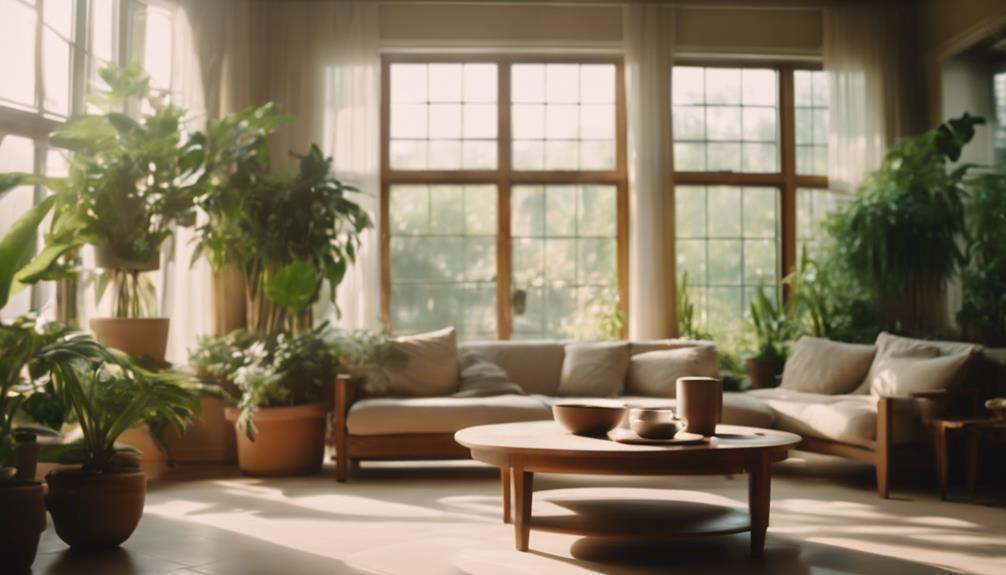
Incorporating natural elements into your sanctuary not only enhances its aesthetic appeal but also promotes a sense of calm and well-being. To create a truly relaxing sanctuary, start by introducing indoor plants and fresh flowers. These elements of nature can greatly improve your mental health by reducing stress and enhancing focus. Potted plants, in particular, bring life into your indoor spaces and help purify the air.
Utilize natural materials like wood and stone in your decor to foster a warm atmosphere. You might consider a small water feature, like a tabletop fountain, to introduce soothing sounds that enhance relaxation. Position your seating areas near windows to maximize natural light and enjoy views of outdoor spaces, which can boost your mood and alleviate anxiety.
Creating Comfortable Spaces
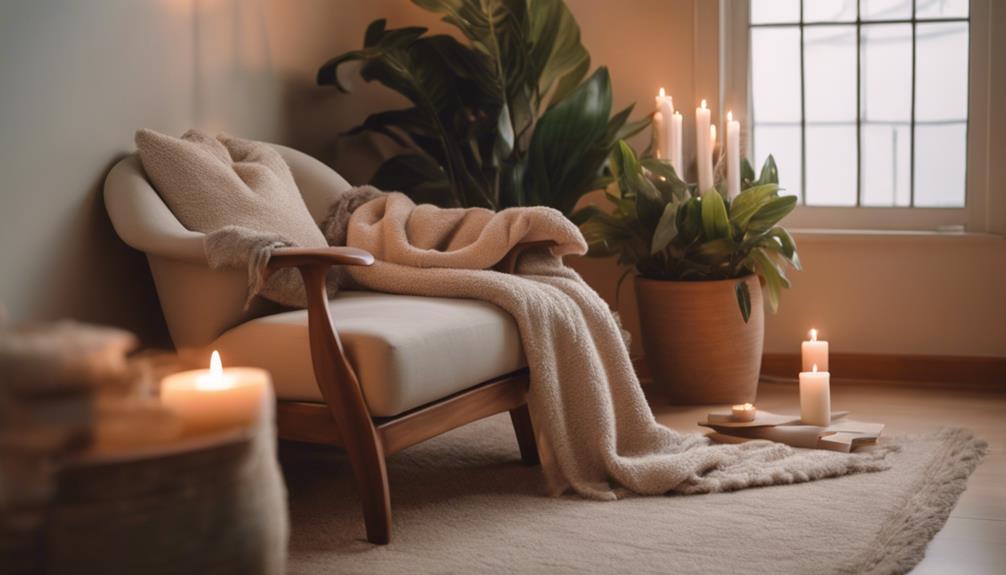
Creating comfortable spaces is essential for transforming your home into a true sanctuary where you can relax and recharge. To make your home a haven, start with plush furnishings like armchairs and chaise lounges that invite you to unwind after a long day. These pieces not only provide comfort but also encourage you to feel safe and secure in your environment.
In your living room, incorporate soft textiles such as blankets, cushions, and pillows. These elements enhance comfort and promote a cozy atmosphere, making it easier to enjoy your downtime. Choose natural materials like cotton, linen, and wool for upholstery and textiles, as they contribute to a soothing environment that feels warm and inviting.
Also, design spaces that prioritize ease of movement and accessibility. Arrange your furniture in a way that facilitates relaxation and interaction, creating a welcoming atmosphere for both you and your guests.
Enhancing Ambiance and Atmosphere
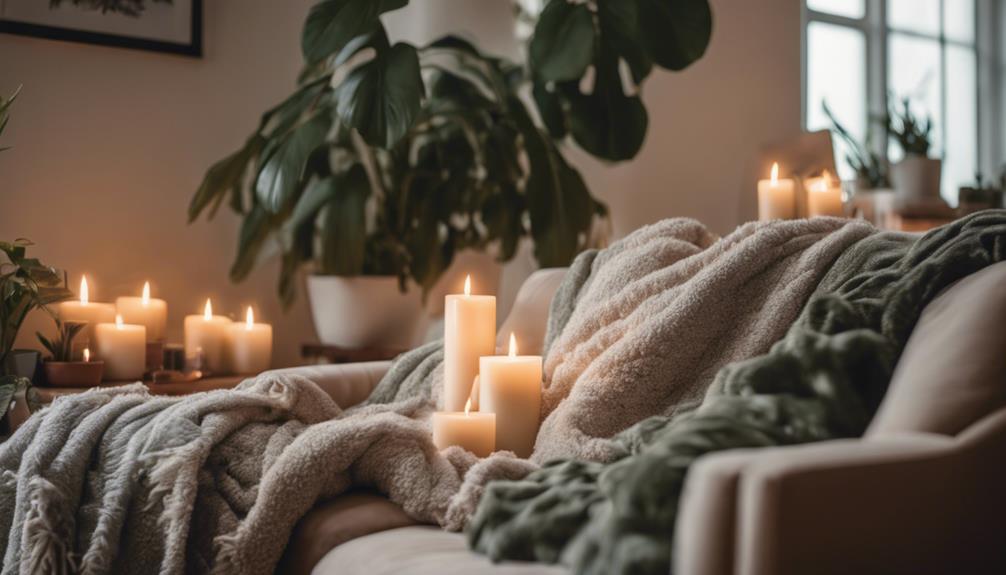
Transforming your home into a sanctuary also involves enhancing the ambiance and atmosphere to elevate your relaxation experience. Start by utilizing soft, diffused lighting sources like floor lamps and dimmer switches. This warm lighting can make you feel more at ease and create a relaxing space.
Pair this with calming color palettes—think muted earth tones or pastels—to evoke serenity throughout your area of your home.
To further enhance the ambiance, introduce soothing scents through essential oils, scented candles, or incense. These aromas can greatly impact your mood, promoting relaxation and comfort.
Additionally, focus on your sound environment; using sound machines or curated playlists with nature sounds and soft music can effectively mask external noise, fostering tranquility.
Personalizing Your Sanctuary
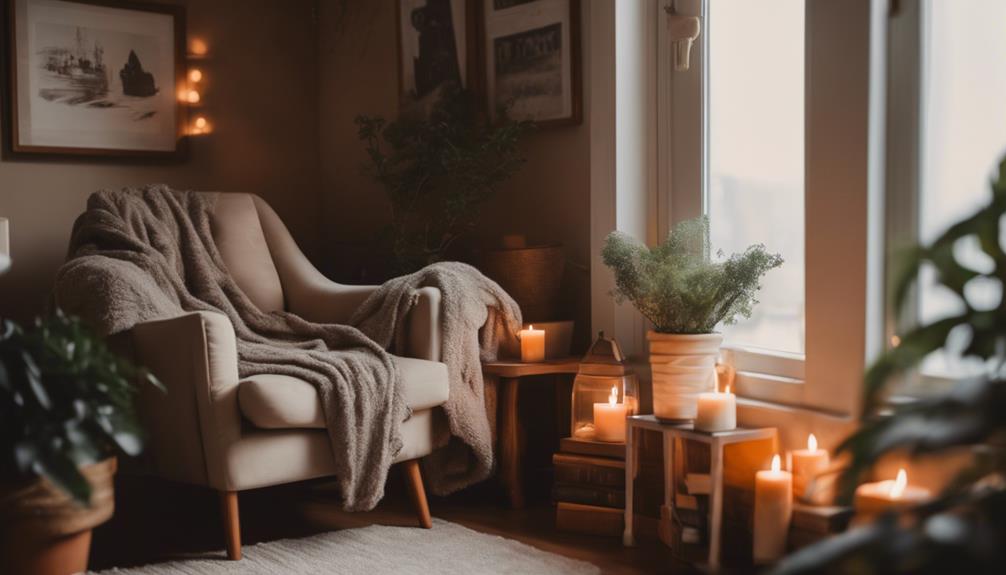
Personalizing your sanctuary means surrounding yourself with items that reflect your identity and evoke positive emotions. To create a space that truly feels like yours, consider incorporating personal mementos, such as cherished photographs or meaningful artwork. These pieces can make your sanctuary a comforting resting place, enhancing the atmosphere with emotional connections.
Additionally, think about using your favorite scents through essential oils or scented candles. Scents like lavender or chamomile can greatly affect how you feel in your space. Create dedicated areas for activities you love—perhaps a cozy reading nook or a meditation corner—to guarantee your sanctuary mirrors your interests.
To keep your sanctuary fresh and aligned with your evolving tastes, regularly update your decor with new items or seasonal changes. A vision board featuring personal goals can also inspire you and serve as a motivational focal point.
Here's a quick overview of ways to personalize your sanctuary:
| Item Type | Purpose | Example |
|---|---|---|
| Personal Mementos | Create emotional connections | Family photos, artwork |
| Scented Candles | Foster relaxation | Lavender, chamomile scents |
| Activity Areas | Reflect interests and hobbies | Reading nook, meditation corner |
Frequently Asked Questions
How to Turn Your Home Into a Sanctuary?
To turn your home into a sanctuary, choose a quiet area, add natural elements, and select comfortable furnishings. Control lighting and personalize the space with meaningful items, creating an inviting atmosphere that promotes relaxation.
How to Create a Peaceful Space at Home?
To create a peaceful space at home, you've got to balance chaos with tranquility. Choose a quiet corner, add calming colors, and surround yourself with nature to cultivate a serene atmosphere that invites relaxation.
What Is a Relaxing Sanctuary?
A relaxing sanctuary is your personal retreat designed for peace and mindfulness. It's a clutter-free space filled with natural light, comfortable furnishings, and personal touches that help you unwind and rejuvenate from daily stresses.
How Do I Make My Living Room a Sanctuary?
"Home is where the heart is." To make your living room a sanctuary, choose calming colors, add comfy furniture, maximize natural light, incorporate greenery, and control lighting for a soothing, inviting atmosphere you'll love.
Conclusion
By transforming your home into a relaxing sanctuary, you're not just creating a space; you're crafting a blissful retreat where stress evaporates faster than morning dew.
Imagine sinking into plush cushions as soft light dances around the room, and the soothing scent of lavender wraps around you like a warm hug.
Each corner radiates tranquility, making your home feel like a five-star spa, where every moment is a mini-vacation.
So go ahead, let your sanctuary work its magic!
Home Decor
Amazing August Color Palettes to Revamp Your Home – Try Them Today!
I found the perfect color palettes to transform your home this August—discover how to infuse seasonal vibes into your space!
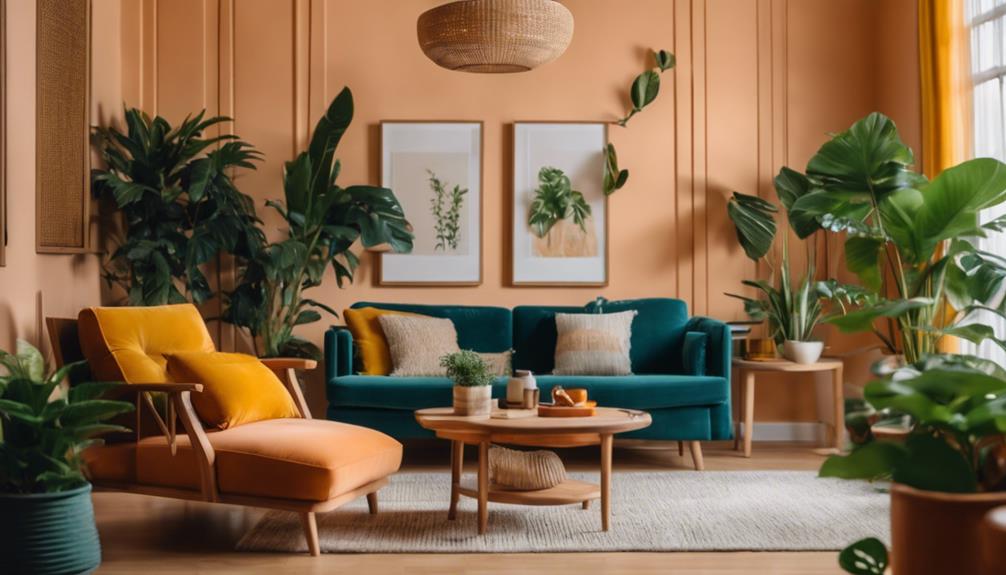
Revamping your home this August? Consider using bold color palettes that reflect the season's spirit! Try burnt reds, coral, and soft yellows to capture summer vibes while hinting at autumn. Earthy tones add warmth, making your space feel cozy and inviting. Don't forget to incorporate accent colors through throw pillows or art to create depth. You can personalize your space by analyzing your favorite wardrobe colors or drawing inspiration from nature. Small changes can have a big impact. Explore seasonal trends and smart tips for your home to discover the perfect palette tailored just for you!
Key Takeaways
- Incorporate warm color palettes like burnt reds and oranges to embrace late summer vibes and signal autumn's approach.
- Refresh your space effortlessly with vibrant throw pillows in hues like coral and pale orange for a lively atmosphere.
- Utilize earthy tones and bright accents to create a cozy retreat that reflects your personal style and mood.
- Analyze your wardrobe colors for inspiration, and create a cohesive aesthetic throughout your home using your favorite tones.
The Power of Color Palettes
Color palettes hold the power to transform your space, making decorating decisions easier and creating a cohesive look throughout your home. By selecting a defined color palette, you can effortlessly combine colors together, ensuring that every room complements one another. Aim for 4-5 paint colors that harmonize well; this creates an inviting atmosphere and enhances the overall aesthetic appeal of your living spaces.
Your personal color preferences play a significant role in shaping the mood of a room. Whether you gravitate towards bold hues or soft pastels, the right colors can reflect your unique style. Consider incorporating an accent color to add depth and interest, bringing your vision to life.
Don't forget about seasonal adjustments! Revitalizing your color palette according to the time of year can keep your home feeling lively and current. Utilize a mood board to visualize various color combinations and find what resonates with you.
Seasonal Trends for August
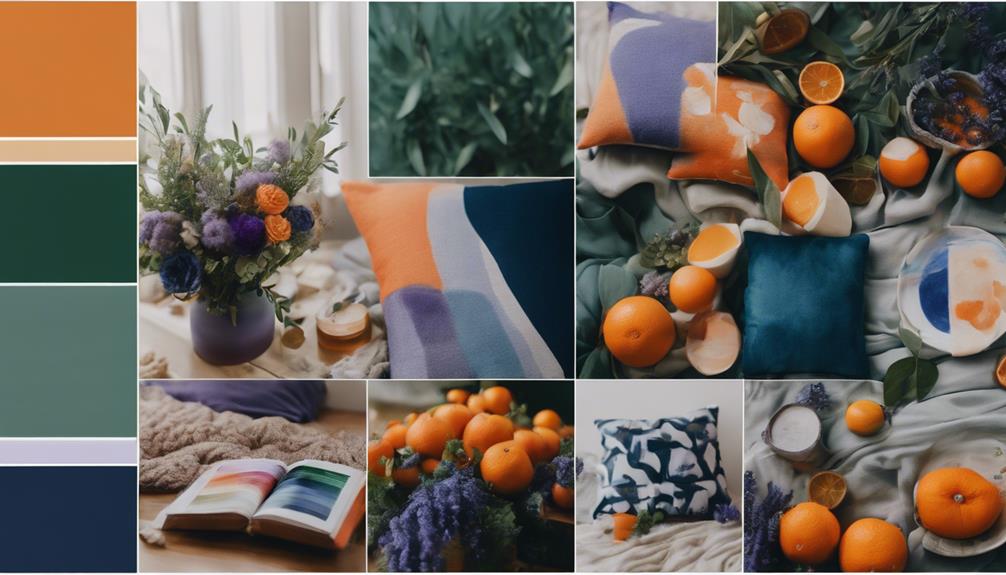
As August rolls in, it's time to refresh your home with trending colors that capture the essence of the season.
You can embrace burnt reds and oranges for a warm shift to autumn or incorporate coral and yellow hues to keep that summer energy alive.
Small decor changes, like adding earthy tones and vibrant accents, can transform your space into a cozy retreat.
Trending August Colors
August brings a vibrant palette of warm tones and earthy hues, perfect for capturing the essence of summer's end and autumn's approach. This month, you'll find popular colors like burnt red and orange, which reflect the dynamic energy of summer while hinting at the changes ahead. Earthy hues such as rust and bright blue are trending, symbolizing the shifting leaves and clear skies.
To create a cozy atmosphere in your home, consider incorporating colors like coral and pale orange. These shades evoke warmth and nostalgia, making them ideal for summer gatherings. Accent colors like pearl and yellow can also add a cheerful touch to your seasonal decor.
A simple way to refresh your space is by rotating throw pillows and linens in these trending colors. Not only do these warm tones provide a soft, inviting ambiance, but they also enhance the overall vibe of your home. By embracing these colors, you can easily shift your decor from the height of summer to the welcoming embrace of autumn, ensuring your space remains stylish and inviting throughout the changing seasons.
Seasonal Decor Inspirations
Shifting your decor this month can be a delightful way to embrace the warmth of late summer while subtly hinting at the upcoming fall. To create a cozy home feel, consider incorporating a warm color palette with seasonal colors like burnt red and orange. These hues not only reflect the change to autumn but also enhance the carefree summer vibe.
You can easily refresh your space by adding vibrant throw pillows and linens in shades of pale orange or coral. These small updates breathe new life into your environment without breaking the bank. Don't forget to rotate decorative elements throughout your home to align with August's color trends; even minor changes can greatly enhance the ambiance of your living areas.
Embrace natural materials, such as jute or wicker, to foster a connection to your surroundings. These elements complement the warm color palette beautifully while adding texture and depth to your decor.
Personalizing Your Space
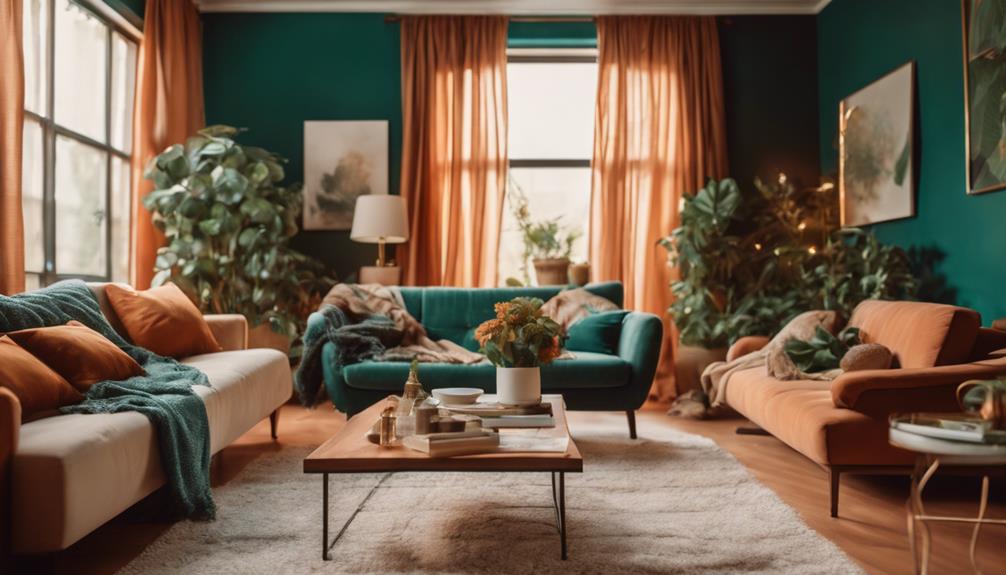
Personalizing your space starts with analyzing your wardrobe colors to identify your favorite tones that can seamlessly translate into your home decor. This approach creates a cohesive aesthetic that reflects your unique style. For instance, if you love shades of blue, consider how to incorporate those tones into your living room and throughout your home.
Here's a simple table to visualize your color choices:
| Color Family | Paint Options | Accent Colors |
|---|---|---|
| Shades of Blue | Soft Sky Blue | Bright Coral |
| Warm Neutrals | Creamy Beige | Deep Teal |
| Earthy Greens | Olive Green | Warm Mustard |
| Bold Reds | Rich Cherry Red | Soft Gray |
| Cool Grays | Light Charcoal | Vibrant Yellow |
Using a mood board can help clarify your design vision. Also, consider seasonal color adjustments to refresh your decor, making it easy to express individuality. Remember to use accent colors strategically—playful hues in children's spaces or calming tones in bedrooms help maintain a harmonious overall look while personalizing your space.
Sources of Color Inspiration

Often, you can find color inspiration in everyday life, from the vibrant hues of nature to the latest fashion trends. Start by analyzing wardrobe colors; those favorite tones can easily translate into your home decor. Look at the bold colors you gravitate towards in your clothes—they might inspire the perfect paint color for different rooms in your home.
Seasonal changes also play a significant role in color inspiration. As the seasons shift, so do the colors around you. Embrace the bright outdoor hues in spring to refresh your whole house color scheme, or opt for warm, cozy tones in the fall. Creating mood boards by collecting images and samples can help clarify your personal style and facilitate the exploration of potential palettes.
Don't shy away from daring combinations. Pairing unexpected colors from eclectic sources can lead to a unique home aesthetic that reflects your personality. When you choose a paint, consider how each color works together to create an inviting atmosphere.
With these sources of inspiration, revamping your space becomes an exciting journey that transforms your home into a beautiful reflection of you.
Common Color Mistakes
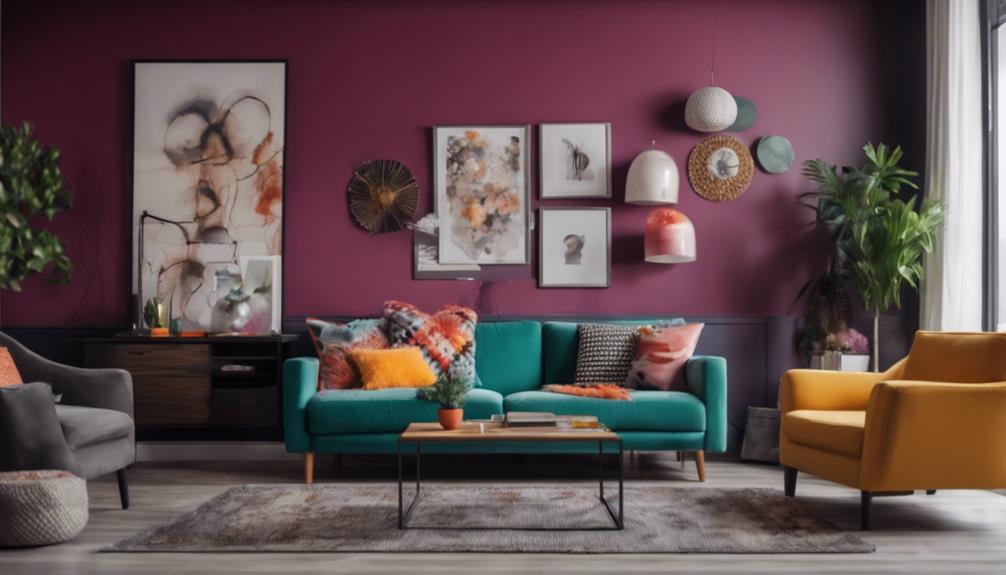
Choosing colors for your home can be exciting, but making spontaneous decisions without a cohesive plan can lead to common mistakes that disrupt your overall aesthetic. Here are some common pitfalls to avoid:
| Mistake | Solution |
|---|---|
| Ignoring lighting conditions | Test colors in different lighting |
| Mismatched wall and trim color | Choose colors that work well together |
| Overlooking seasonal colors | Adapt your palette to reflect the season |
| Clashing different styles | Stick to a unifying theme |
| Skipping paint samples | Always sample before you commit |
To create a harmonious space, consider how your white trim color interacts with the wall color in your living rooms. Different colors can evoke various emotions, so reflect your personality through your choices. Remember, colors can look drastically different based on lighting conditions; what seems perfect during the day may feel off at night. Finally, embrace seasonal color changes—they can breathe new life into your home and match your mood. By avoiding these common mistakes, you'll create a beautiful, cohesive environment that truly feels like home.
Room-Specific Color Recommendations
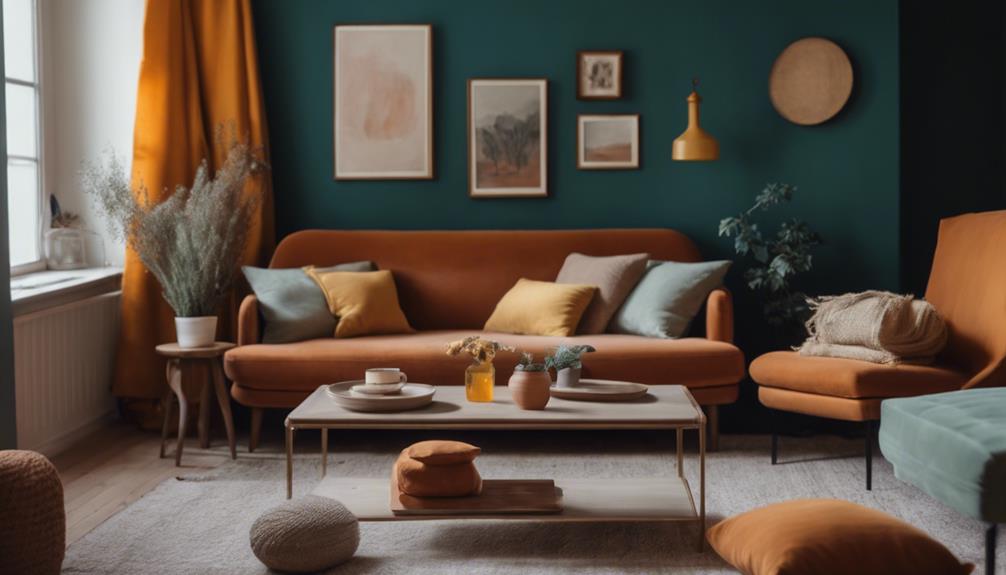
When selecting colors for specific rooms, it's essential to contemplate how each hue can enhance the function and mood of the space.
For your main living spaces, consider using Benjamin Moore Ballet White. This creamy warm white serves as a versatile backdrop, allowing your decor to shine.
In the guest bath, try Sherwin Williams Clary Sage; it pairs beautifully with creamy shower tiles and brass fixtures, creating a fresh and inviting atmosphere.
Your main bedroom can greatly benefit from Benjamin Moore Boothbay Gray, which features calming blues and greens with warm undertones, fostering a serene vibe.
For children's rooms, Valspar Warm Fog offers a lovely blush hue that can be accentuated with custom chair rails and molding, making it playful yet sophisticated.
If you're revamping a home office, opt for a deep navy accent wall using Valspar Chimney Smoke. This striking contrast against Ballet White adds elegance and focus to your workspace.
Engaging With Color Communities
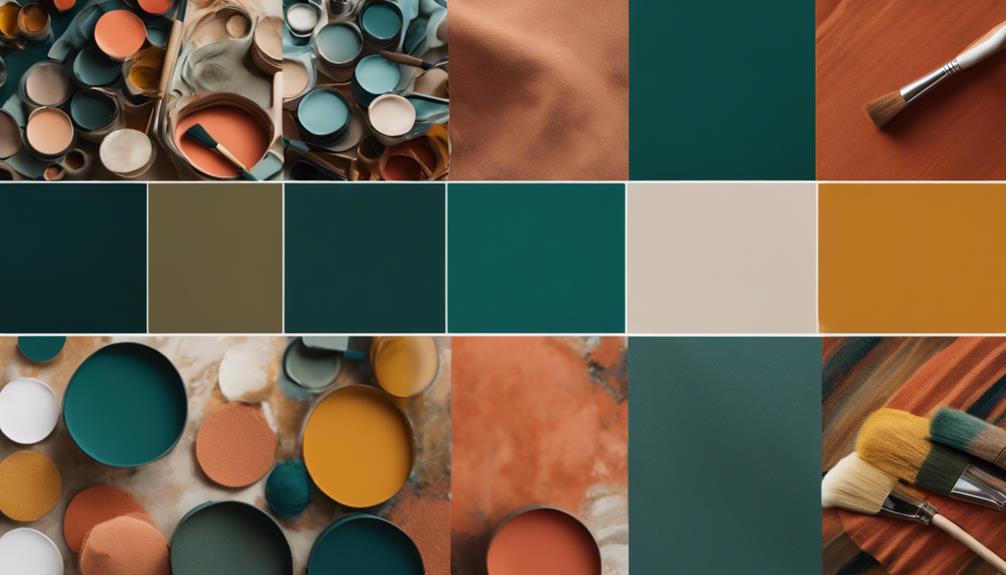
Engaging with color communities opens up a treasure trove of shared experiences and insights that can elevate your design journey. By participating in these vibrant groups, you can discover how your favorite colors look different in various contexts and gain inspiration for that fun color palette you've been dreaming of.
Through feedback sessions, you'll be able to refine your choices, ensuring you select the right color for your space. Plus, many communities provide handy resources like color palette generators and mood board tools, which are essential for visualizing color concepts before you immerse yourself.
Here's a quick look at some community benefits:
| Benefit | Description |
|---|---|
| Shared Experiences | Learn from others' design journeys and choices |
| Resource Access | Utilize tools for color palette generation |
| Accountability | Share projects to motivate and inspire each other |
| Trend Discussions | Stay updated on the latest color trends |
| Polls & Feedback | Get opinions on your color selections and ideas |
Engaging with color communities not only enriches your palette but also makes the design process more enjoyable and collaborative throughout every step!
Frequently Asked Questions
What Is the Color Scheme for August?
August's color scheme features warm burnt reds, oranges, and cheerful yellows. You can balance these vibrant tones with deep blues and greens, creating an inviting atmosphere that reflects the shift from summer to autumn.
What Color Goes Best With August?
For August, deep blues pair beautifully with burnt reds and oranges, creating a cozy yet vibrant atmosphere. Soft neutrals balance these colors, ensuring your space feels inviting and harmonious as you move into autumn.
What Is Joanna Gaines' Favorite Grey Color?
Joanna Gaines' favorite gray color is Sherwin Williams Repose Gray. It adapts beautifully to different lighting, creating a calming atmosphere while complementing both modern and traditional designs, making it perfect for any living space you choose.
What Color Paint Does Joanna Gaines Use on Fixer Upper?
Imagine stepping into a serene haven—Joanna Gaines often paints with soft hues like Sherwin Williams Sea Salt and Mindful Gray, blending dusty blues and creamy whites to create inviting, calming spaces that feel effortlessly cozy.
Conclusion
As August unfolds like a vibrant canvas, it's the perfect time to breathe new life into your home.
Embrace the warmth of rich hues and cool tones, weaving together a tapestry of comfort and style.
Remember, each splash of color tells your story, so don't shy away from personal touches.
Immerse yourself in the world of color, and let your imagination dance.
After all, your home should reflect the beautiful symphony of who you are.
-

 Vetted2 months ago
Vetted2 months ago14 Best Personalized Father's Day Gifts for Your Husband – Show Him You Care
-

 Alfresco1 month ago
Alfresco1 month agoAlfresco Stacker Doors: Seamless Indoor-Outdoor Living!
-

 Craft and Textiles3 months ago
Craft and Textiles3 months ago15 Best Places to Buy Appliances for Your Home – Top Retailers Reviewed
-

 Decorative Throws3 months ago
Decorative Throws3 months agoIs It Better to Dry Clean Blankets?
-

 Tableware and Dining Accessories3 months ago
Tableware and Dining Accessories3 months agoWhat Is the Meaning of the Word Tableware
-

 Tableware and Dining Accessories3 months ago
Tableware and Dining Accessories3 months agoWhat Is the Hindi Meaning of Tableware
-

 Craft and Textiles3 months ago
Craft and Textiles3 months ago15 Best Cordless Mowers for Effortless Lawn Care – Top Picks of 2024
-

 Craft and Textiles3 months ago
Craft and Textiles3 months ago15 Best Battery-Powered Leaf Blowers for Effortless Yard Work























